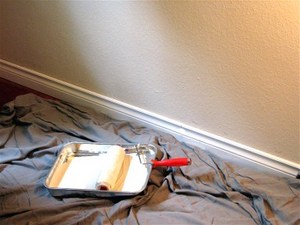This week I learned that paint touch ups can be a nightmare. I went to the trouble of saving all the paint color lids for every room, so future house painting will be a breeze. It was a nasty surprise to learn that paint color fades with time. My paint touch ups no longer matched the color of my walls.
Luckily there is a house painting solution for just this paint touch up problem. Just follow these steps, as I did, and you’ll be able to do paint touch ups here and there even with no matching paint color. It will save you the trouble of house painting every room from scratch.
Determine the Matching Touch Up Paint Color
Pick up a few gradient color swatches at your home improvement store. Compare them to your wall color until you find one that matches your wall paint color best.
Buy the Paint Color Shades to Mix Touch Up Paint
Buy a sample size of this matching paint color, as well as the darker and lighter paint colors from the gradient color swatch.
Prepare Your Paint Touch Up Palette
Wrap a plate in foil paper, then place a large dab of the matching paint color at the center, and two small dabs of the lighter and darker paint colors to each side.
Apply Base Paint Color to Touch Up Area
With a paint brush, touch up the wall with a thin coat of the matching paint color. If the color is slightly lighter, it might dry to a perfect match. Consider yourself lucky. If the paint color is darker or too light, you’ll have to mix your paint touch up color yourself.
Mixing the Touch Up Paint Color
On your palette, mix a little of the lighter or darker shade into the center paint color, then touch up the wall with a thin coat. Continue touching up and blending the lighter or darker paint colors as needed. Expand the touch up area beyond the original size to slowly blend the touch up into the rest of the wall color. As you move from the center, create thinner and thinner smears of paint.
Confirming the Touch Up Paint Color Match
The sides of your touch up area should be almost invisible at this point, as the thin coat of edge paint dries quickly. This transition should fool the eye into thinking that the entire touch up area blends into the wall. The overall touch up paint spot should be a little lighter than the wall, so as to dry to the same paint color.
Sanding the “Newness” Away
Once dry, the new paint touch up is likely to have a “new” sheen that the rest of the wall will no longer have. Use fine (P-320 grit) sand paper to gently remove the upper layer of paint. Begin at the corners of the paint touch up and work your way to the center, wiping the wall with your hand as you go to see if you’ve sanded enough.
Reference:
Inventive Home Improvement: How to Paint Touch Up Your House with No Matching Color







